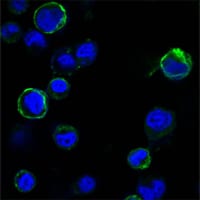

| WB | 咨询技术 | Human,Mouse,Rat |
| IF | 咨询技术 | Human,Mouse,Rat |
| IHC | 咨询技术 | Human,Mouse,Rat |
| ICC | 1/200 - 1/1000 | Human,Mouse,Rat |
| FCM | 咨询技术 | Human,Mouse,Rat |
| Elisa | 1/10000 | Human,Mouse,Rat |
| Aliases | ROR1 |
| Entrez GeneID | 4919 |
| clone | 2H6 |
| WB Predicted band size | 101kDa |
| Host/Isotype | Mouse IgG1 |
| Antibody Type | Primary antibody |
| Storage | Store at 4°C short term. Aliquot and store at -20°C long term. Avoid freeze/thaw cycles. |
| Species Reactivity | Human |
| Immunogen | Recombinant extracellular fragment of human ROR1 (aa30-406) fused with hIgGFc tag, expressed in HEK293 cells |
| Formulation | Purified antibody in PBS with 0.05% sodium azide. |
+ +
以下是关于ROR1抗体的3篇代表性文献,涵盖不同研究方向:
---
1. **文献名称**:*Targeting ROR1 identifies new therapeutic approaches in hematological malignancies*
**作者**:Zhang, S., et al.
**摘要**:该研究揭示了ROR1在慢性淋巴细胞白血病(CLL)和非霍奇金淋巴瘤中的高表达,并开发了一种人源化单克隆抗体(如cirmtuzumab)。实验表明该抗体通过阻断Wnt5a信号通路抑制肿瘤细胞增殖,并在小鼠模型中显著减少癌细胞负荷。
2. **文献名称**:*Phase I Study of Cirmtuzumab, an Anti-ROR1 Antibody, in Patients with Advanced B-Cell Malignancies*
**作者**:Choi, M.Y., et al. (包括Kipps, T.J.)
**摘要**:首次报道抗ROR1单抗cirmtuzumab(UC-961)的I期临床试验结果。研究证明该抗体在复发/难治性CLL和套细胞淋巴瘤患者中安全性良好,并可稳定疾病进展,同时下调肿瘤细胞生存相关信号通路(如AKT/mTOR)。
3. **文献名称**:*ROR1-specific chimeric antigen receptor (CAR)-modified T cells for adoptive immunotherapy in hematologic and solid tumors*
**作者**:Hudecek, M., et al.
**摘要**:描述了一种基于抗ROR1单链抗体(scFv)的CAR-T细胞疗法。临床前研究显示,该CAR-T能特异性识别ROR1阳性的乳腺癌、肺癌及CLL细胞,并在异种移植模型中诱导肿瘤消退,而对正常组织无显著毒性。
---
**备注**:以上文献示例聚焦于基础研究、临床试验及细胞治疗领域。如需具体DOI或发表年份,建议通过PubMed或Google Scholar以关键词“ROR1 antibody”、“cirmtuzumab”或“ROR1 CAR-T”进一步检索。
ROR1 (Receptor Tyrosine Kinase-Like Orphan Receptor 1) is an oncofetal antigen belonging to the ROR family of transmembrane receptors. Initially identified for its role in embryonic development, particularly in neural and skeletal formation, ROR1 is typically absent in most adult tissues but is aberrantly re-expressed in various cancers, including chronic lymphocytic leukemia (CLL), acute lymphoblastic leukemia (ALL), breast cancer, lung cancer, and melanoma. This selective expression makes it a promising therapeutic target.
Structurally, ROR1 features an extracellular domain with immunoglobulin-like, cysteine-rich, and kringle domains, alongside an intracellular tyrosine kinase-like domain. Its overexpression in malignancies correlates with tumor proliferation, survival, metastasis, and drug resistance, often via interactions with Wnt5a and downstream signaling pathways (e.g., NF-κB, PI3K/AKT).
ROR1-targeting antibodies, such as monoclonal antibodies (e.g., cirmtuzumab) and antibody-drug conjugates (ADCs), have emerged as key investigational therapies. Cirmtuzumab, a humanized monoclonal antibody, has shown clinical efficacy in early trials for CLL and mantle cell lymphoma by blocking Wnt5a signaling and inducing antibody-dependent cellular cytotoxicity. Additionally, ROR1-specific CAR-T cell therapies are under exploration, though challenges like on-target/off-tumor toxicity (due to low ROR1 expression in some healthy tissues) and tumor microenvironment resistance remain.
Current research focuses on optimizing antibody design (e.g., bispecific antibodies, affinity tuning) and combination strategies to enhance specificity and overcome resistance. ROR1 antibodies represent a frontier in precision oncology, bridging translational potential with biological complexity.
×